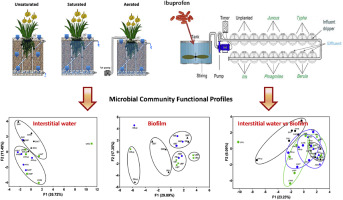Water Research ( IF 12.8 ) Pub Date : 2017-12-23 , DOI: 10.1016/j.watres.2017.12.050 Liang Zhang , Tao Lyu , Yang Zhang , Mark Button , Carlos A. Arias , Kela P. Weber , Hans Brix , Pedro N. Carvalho

|
Microbial degradation is an important pathway during the removal of pharmaceuticals in constructed wetlands (CWs). However, the effects of CW design, plant presence, and different plant species on the microbial community in CWs have not been fully explored. This study aims to investigate the microbial community metabolic function of different types of CWs used to treat ibuprofen via community-level physiological profiling (CLPP) analysis. We studied the interactions between three CW designs (unsaturated, saturated and aerated) and six types of mesocosms (one unplanted and five planted, with Juncus, Typha, Berula, Phragmites and Iris) treating synthetic wastewater. Results show that the microbial activity and metabolic richness found in the interstitial water and biofilm of the unsaturated designs were lower than those of the saturated and aerated designs. Compared to other CW designs, the aerated mesocosms had the highest microbial activity and metabolic richness in the interstitial water, but similar levels of biofilm microbial activity and metabolic richness to the saturated mesocosms. In all three designs, biofilm microbial metabolic richness was significantly higher (p < .05) than that of interstitial water. Both the interstitial water and biofilm microbial community metabolic function were influenced by CW design, plant presence and species, but design had a greater influence than plants. Moreover, canonical correlation analysis indicated that biofilm microbial communities in the three designs played a key role in ibuprofen degradation. The important factors identified as influencing ibuprofen removal were microbial AWCD (average well color development), microbial metabolic richness, and the utilization of amino acids and amine/amides. The enzymes associated with co-metabolism of L-arginine, L-phenyloalanine and putrescine may be linked to ibuprofen transformations. These results provide useful information for optimizing the operational parameters of CWs to improve ibuprofen removal.
中文翻译:

设计构型和植物对中尺度规模人工湿地治疗布洛芬的微生物群落功能的影响
微生物降解是在人工湿地(CWs)中去除药物过程中的重要途径。然而,尚未充分研究连续水的设计,植物的存在以及不同植物种类对连续水的微生物群落的影响。本研究旨在通过社区水平的生理特征分析(CLPP)分析调查用于治疗布洛芬的不同类型CW的微生物群落代谢功能。我们研究了三种CW设计(不饱和,饱和和充气)和六种类型的中观(Juncus,Typha,Berula,Phragmites和Iris)之间的相互作用。)处理合成废水。结果表明,在不饱和设计的间隙水和生物膜中发现的微生物活性和代谢丰富度低于饱和和充气设计的微生物活动和代谢丰富度。与其他连续波设计相比,充气的中膜在间质水中具有最高的微生物活性和代谢丰富度,但与饱和的中膜具有相似水平的生物膜微生物活性和代谢丰富度。在所有三种设计中,生物膜微生物代谢丰富度均显着更高(p <.05)比间隙水要低。间隙水和生物膜微生物群落的代谢功能均受CW设计,植物存在和物种的影响,但设计比植物具有更大的影响。此外,典型的相关性分析表明,三种设计中的生物膜微生物群落在布洛芬降解中起关键作用。被确定为影响布洛芬去除的重要因素是微生物AWCD(平均孔颜色发展),微生物代谢丰富度以及氨基酸和胺/酰胺的利用。与L-精氨酸,L-苯丙氨酸和腐胺共同代谢相关的酶可能与布洛芬转化有关。这些结果为优化CW的操作参数以改善布洛芬的去除提供了有用的信息。


























 京公网安备 11010802027423号
京公网安备 11010802027423号